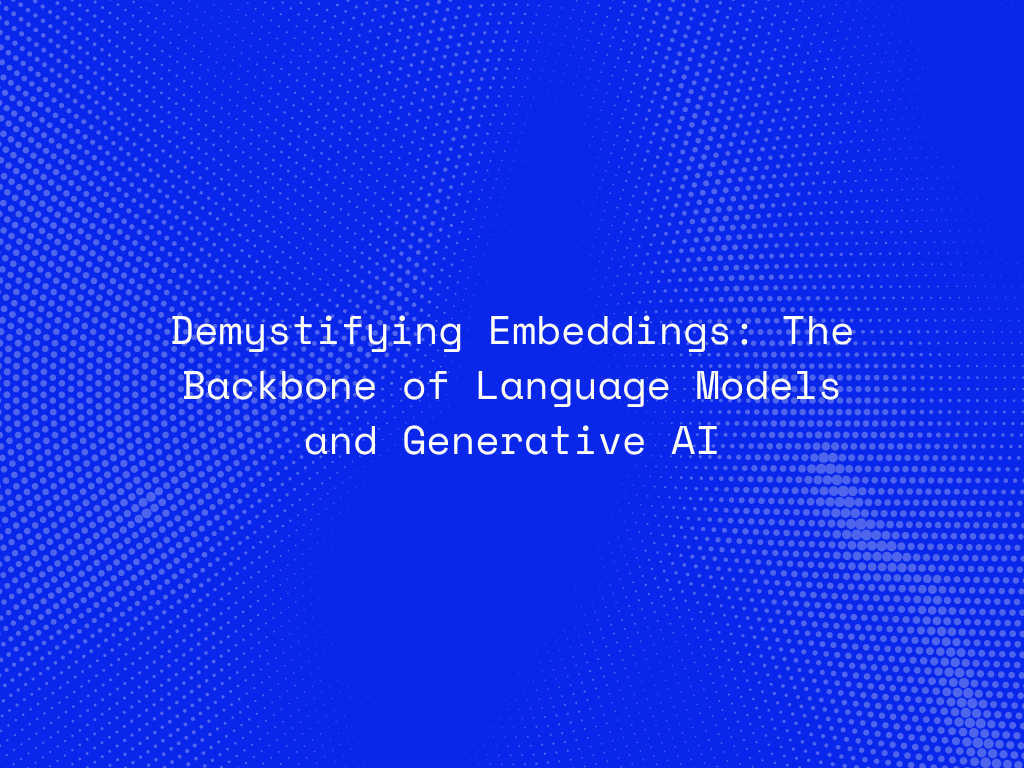Embeddings have become ubiquitous in natural language processing (NLP) and artificial intelligence (AI), enabling computers to understand human languages better than ever before. They play a crucial role in capturing meaning, relationships, and structure within vast amounts of unstructured text data. However, despite their significance, many people remain unfamiliar with the concept of embeddings and how they contribute to powerful language models and generative AI. In this article, we will delve into embeddings, exploring their definition, types, applications, inner workings, challenges, and limitations. By understanding embeddings more deeply, we can appreciate the remarkable progress made in recent years while recognizing opportunities for further advancements.
What are embeddings?
At its core, an embedding refers to a continuous, low-dimensional vector representation of discrete symbols, such as words, characters, or even whole documents. These dense vectors capture essential properties of the original symbolic inputs, including semantic meanings, grammatical roles, and syntactical functions. For example, the words “dog,” “puppy,” and “canine” might share similar vector representations because they all pertain to the same general idea—man’s best friend. Thus, embeddings enable machines to process high-level abstractions instead of raw character sequences or sparse one-hot encoded vectors.
The primary goal of embeddings is dimensionality reduction—transforming high-dimensional categorical variables into lower-dimensional numerical ones—while preserving critical features and patterns inherent in the data. This transformation not only makes computations faster but also facilitates modeling complex interactions among linguistic elements through simple arithmetic operations. As a result, embeddings serve as indispensable building blocks for numerous downstream NLP applications.
Types of embeddings
Several techniques exist for generating embeddings based on varying objectives and mathematical principles. Some popular approaches include:
Word2Vec
Developed by Mikolov et al. at Google, Word2Vec comprises two algorithms: Continuous Bag Of Words (CBOW) and Skip-gram. Both aim to predict target words given surrounding context or vice versa. Through co-occurrence statistics and shallow neural networks, Word2Vec generates fixed-size vectors encoding subtle distinctions between synonyms, antonyms, hypernyms, hyponyms, and other linguistically relevant concepts.
Global Vectors (GloVe)
An alternative approach introduced by Pennington et al. at Stanford University, GloVe combines global matrix factorization techniques with local context windows used in Word2Vec. Specifically, it trains on the logarithmically scaled co-occurrence counts of words within predefined sliding windows across massive corpora. Ultimately, GloVe produces stable and robust embeddings capable of reproducing analogies learned via linear algebraic manipulations, e.g., “king” − “man” + “woman” ≈ “queen.”
FastText
FastText, developed by Facebook Research, extends Word2Vec by representing each word as a bag of n-gram characters rather than individual tokens. This allows FastText to handle out-of-vocabulary terms efficiently since it can compose embeddings from smaller n-gram components. Additionally, FastText incorporates subword information during optimization, which often leads to superior performance compared to traditional word-embedding methods.
Contextualized Embeddings (ELMo, BERT, etc.)
Contextualized embeddings differ significantly from previous techniques due to their ability to generate distinct representations for every occurrence of a word depending on its surroundings. Unlike earlier methods producing static embeddings per token type, these deep learning–based models dynamically adjust vectors according to the specific sentence context using multi-layer bidirectional recurrent neural networks (RNNs) or self-attention mechanisms. Examples include ELMo, BERT, RoBERTa, XLNet, and ELECTRA.
Applications of embeddings
As previously mentioned, embeddings provide valuable insights for multiple NLP tasks, leading to practical implementations across diverse industries. A few notable examples include:
- Text classification: Identifying the topic, sentiment, genre, or author of written material
- Machine translation: Transforming text from one language to another while retaining meaning and syntax
- Sentiment analysis: Quantifying subjective opinions expressed towards entities, events, or ideas
- Question answering: Extracting precise answers from paragraphs or documents
- Chatbots and conversational agents: Interpreting user queries and providing tailored responses
These capabilities underpin several real-world applications, such as:
- Virtual personal assistants like Siri, Alexa, Cortana, and Google Assistant
- Search engines such as Google, Microsoft Bing, and DuckDuckGo
- Recommendation systems employed by Amazon, Netflix, Spotify, and YouTube
- Content moderation tools utilized by social media platforms like Twitter, Instagram, and Reddit
- Spam filters integrated into email clients and messaging apps
How do embeddings work in large language models?
In contemporary NLP research, transformers dominate state-of-the-art results across various benchmarks and datasets. Notably, large language models relying on these architectures employ contextualized embeddings generated through multi-headed self-attention layers followed by feedforward networks. Two prominent instances include Bidirectional Encoder Representations from Transformers (BERT) and Robustly Optimized BERT Pretraining Approach (RoBERTa).
Unlike conventional static embeddings, contextualized embeddings account for intricate dependencies existing among words in a sequence. Furthermore, advanced language models may incorporate positional encodings to preserve order information lost during the initial tokenization step. Lastly, these models typically involve finetuning procedures whereby pretrained weights act as warm starters for task-specific objective functions.
Challenges and Limitations
Despite impressive achievements brought forth by embeddings, certain drawbacks persist:
- Out-of-vocabulary words pose significant challenges since most current techniques cannot represent unknown terms effectively without prior knowledge of their existence.
- Polysemous and homonymous words introduce ambiguity when mapping symbols onto single vector spaces, necessitating additional refinement strategies.
- Rare words suffer from insufficient training signals, resulting in poor-quality embeddings.
- Biases inherent in training corpora propagate throughout downstream applications, potentially exacerbating discriminatory practices against marginalized groups.
To address these concerns, researchers continue developing novel embedding techniques and refining existing ones to ensure responsible and inclusive AI development.
Conclusion
Embeddings constitute fundamental cornerstones upon which sophisticated language models and generative AI frameworks rest. Their capacity to encode rich linguistic nuances enables compelling advances across myriad domains, reshaping our interaction with technology daily. While shortcomings remain, continued innovation promises improved interpretability, reliability, and fairness moving forward.




